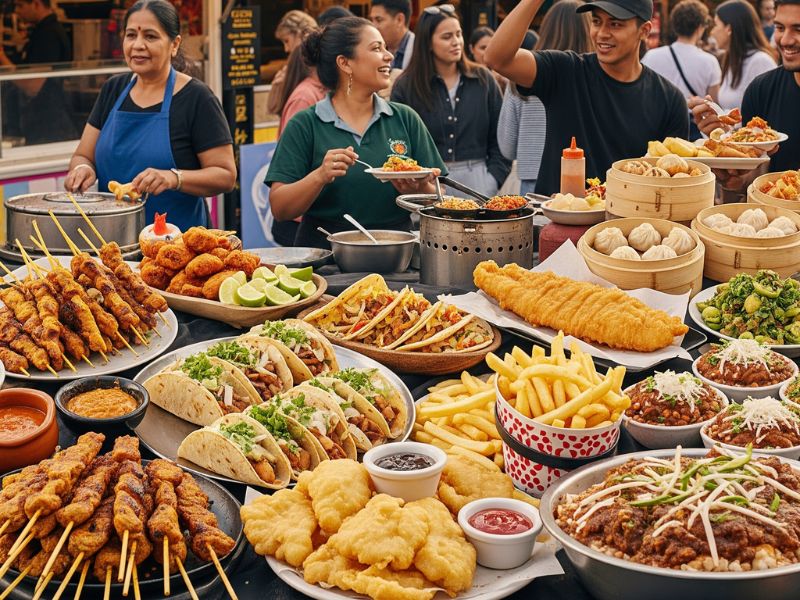Street food is more than just a quick bite to eat. It is a window into culture, tradition, and daily life across the globe. For centuries, vendors on bustling streets, night markets, and town squares have provided affordable and flavorful meals that reflect the soul of their communities. Today, street food has evolved into a celebrated part of global gastronomy, uniting travelers and locals with shared tastes and experiences.
The Flavor Of Local Life
When you travel, one of the most authentic ways to experience a city is through its street food. From tacos in Mexico City to satay skewers in Bangkok, every dish carries history and tradition in its preparation. Street food doesn’t just fill stomachs; it tells stories about migration, trade, and regional resources. A simple noodle dish, for example, can reveal influences from centuries of spice routes and cultural exchange. Even modern digital culture mirrors this diversity, where trends like hidden face cap girl dp symbolize how global communities adapt personal expression into everyday life—much like food reflects the identity of its people.
Asia: The Heartbeat Of Street Food
Asia is often considered the street food capital of the world. Markets in countries like Thailand, India, and Vietnam draw thousands of food lovers daily. Whether it’s pad thai fried on a sizzling wok or freshly steamed dumplings, the variety is endless. In India, spicy chaats and crispy dosas feed millions across cities and small towns alike. These dishes are inexpensive, filling, and packed with bold flavors, making them accessible to everyone.
At the same time, street vendors often innovate while staying rooted in tradition. For instance, bánh mì sandwiches in Vietnam combine French baguettes with local herbs, showcasing a fusion of history and culinary creativity. Street food here doesn’t just nourish; it fosters connection among people from all walks of life.
Europe: Tradition Meets Innovation
Europe’s street food scene has its own unique charm. Classic favorites like Belgian waffles, Italian arancini, or Turkish döner kebabs have transcended borders and become international icons. Yet, cities like London and Berlin are also at the forefront of modern street food culture, with gourmet food trucks offering everything from Korean tacos to vegan burgers.
Markets in Europe are lively cultural hubs, where food blends seamlessly with art, music, and community spirit. Interestingly, digital platforms where people interact daily—such as free classified ads Australia websites, mirror this openness and exchange. Just as individuals buy, sell, and share online, street food markets thrive on this same dynamic of constant interaction and accessibility.
The Americas: Bold And Diverse
In the Americas, street food is a vibrant blend of indigenous traditions and immigrant influences. In Mexico, tacos, tamales, and elotes are cornerstones of daily life, deeply tied to heritage. Meanwhile, in the United States, food trucks have transformed urban dining, making everything from gourmet lobster rolls to Korean BBQ accessible on the go. South America, too, offers treasures such as empanadas in Argentina or arepas in Venezuela, each telling its own story of local identity.
Travelers often discover that these flavors become memorable parts of their journey. A quick search on lifestyle blogs or platforms like https://mysadshayari.com can show how personal experiences with food and travel leave lasting impressions, turning simple meals into cherished memories.

Africa: Rich Heritage In Every Bite
Africa’s street food reflects the continent’s vast diversity. From suya in Nigeria, grilled skewers spiced with peanuts and peppers—to bunny chow in South Africa, flavors are bold and deeply tied to local traditions. In Egypt, koshari, a hearty mix of rice, lentils, pasta, and spices, is a beloved staple. These dishes not only fuel busy city life but also symbolize resilience and creativity in using local ingredients.
For many, the way street food connects communities resembles how marketplaces work in other areas of life. Just as people buy and sell homes to build their future, food vendors rely on street food as a livelihood, passing down recipes through generations and sustaining families with every plate served.
Australia And Beyond: A Melting Pot
In Australia, the street food culture is shaped by multiculturalism. Night markets in cities like Sydney and Melbourne are full of flavors from Asia, Europe, and the Middle East. From dumplings to paella, visitors can sample global tastes in one place, reflecting the country’s diverse population.
Platforms like www.dinepedia.com.au serve as a modern extension of this culinary diversity, helping people explore dining options and cuisines without leaving home. Just as digital platforms connect people to experiences, street food stalls connect individuals to cultures, memories, and communities in tangible, flavorful ways.
The Universal Appeal Of Street Food
Ultimately, the magic of street food lies in its accessibility, affordability, and authenticity. Whether you are a traveler in a foreign country or a local grabbing a familiar favorite, these dishes unite people across social and cultural divides. They provide not just nourishment but also connection—a shared moment of joy over a simple meal.
Street food around the world is proof that food is more than sustenance; it is culture, history, and identity served on a plate. It is an invitation to step into another person’s world, if only for a bite, and leave with a taste of their story.




